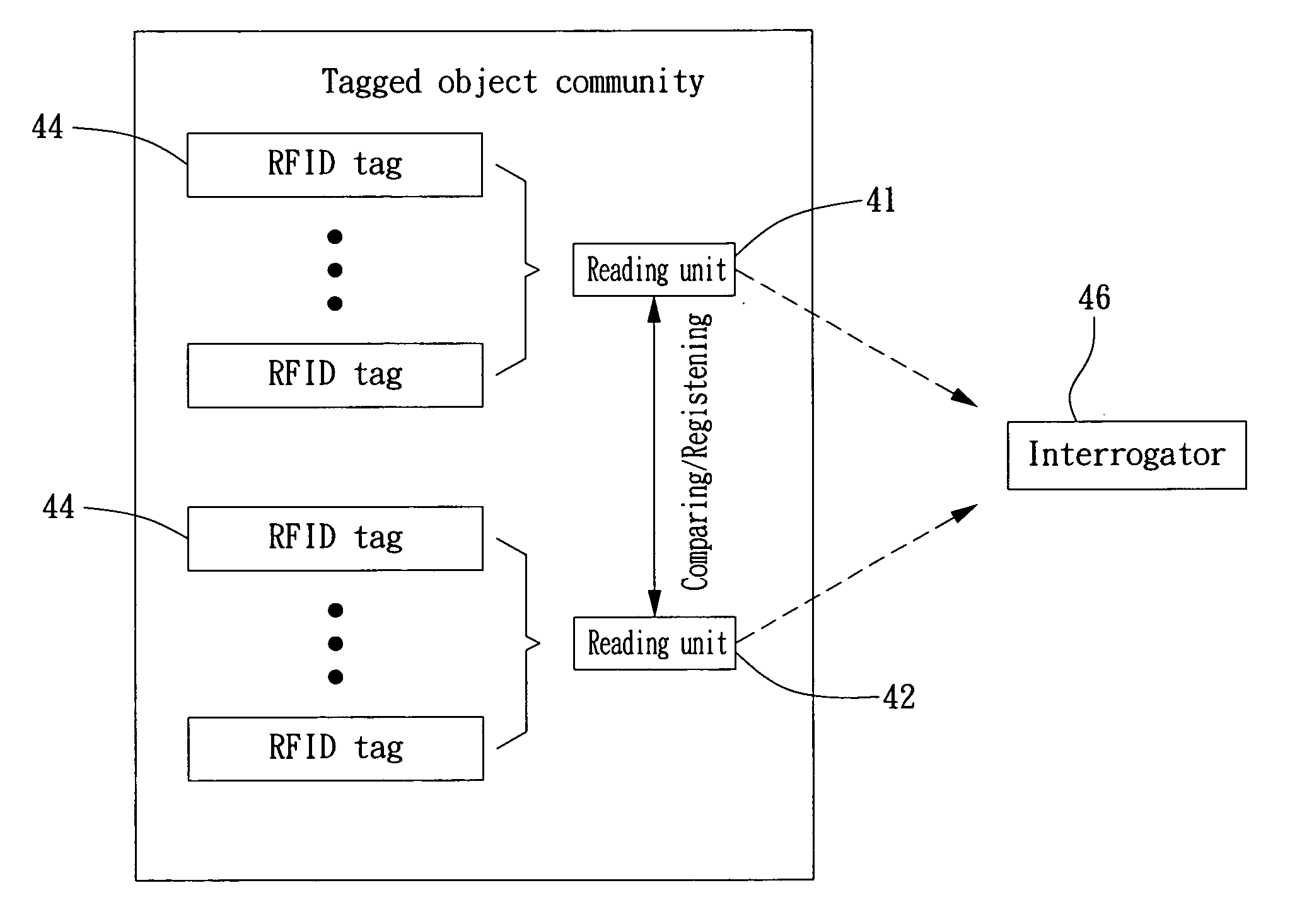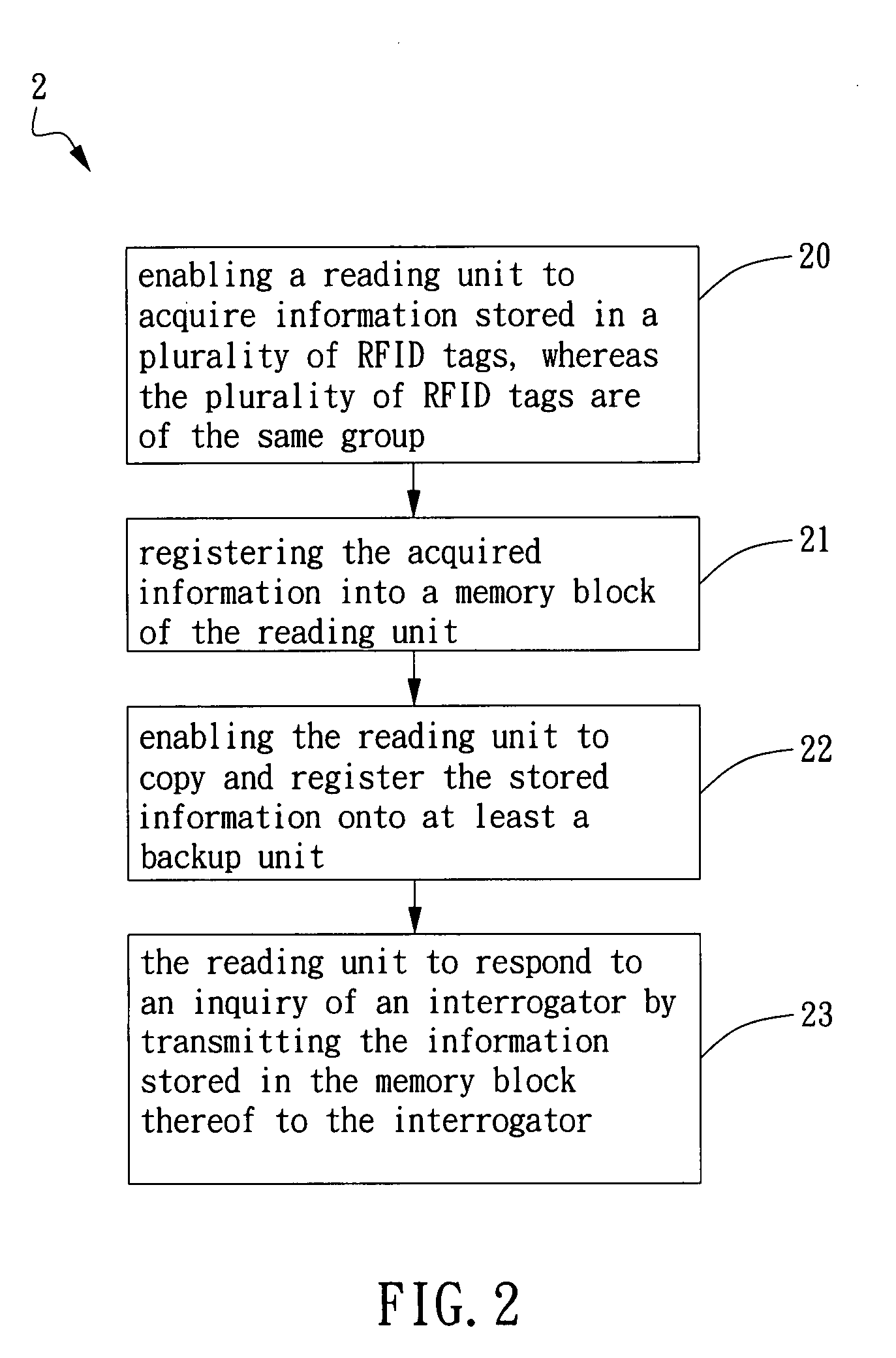Method and system for reading and identifying RFID tag
- Summary
- Abstract
- Description
- Claims
- Application Information
AI Technical Summary
Benefits of technology
Problems solved by technology
Method used
Image
Examples
first embodiment
[0032]Please refer to FIG. 2, which is a flow chart depicting steps of a method for reading and identifying RFID tag in accordance with the invention. The flow starts at step 20. At step 20, a reading unit is enabled to acquire information stored in a plurality of RFID tags, whereas the RFID tags are of the same group, and then the flow proceeds to step 21. At step 21, all the acquired information is registered into a memory block of the reading unit, and then the flow proceeds to step 22. At step 22, the reading unit is enabled to copy and register the stored information onto at least a backup unit, and then the flow proceeds to step 23. At step 23, the reading unit is enabled to respond to an inquiry of an interrogator by transmitting the information stored in the memory block thereof to the interrogator. It is noted that the reading unit can be a RFID reader or an active RFID tag; and the backup unit can be a RFID reader, an active RFID tag or a passive RFID tag.
[0033]In this emb...
second embodiment
[0034]Please refer to FIG. 3, is a flow chart depicting steps of a method for reading and identifying RFID tag in accordance with the invention. The flow of FIG. 3 starts at step 30 and, for clarity, please also refers to FIG. 4A and FIG. 4B for articles addressed in the flow. At step 30, a storage platform 40 is provided, on which at least a reading unit is being arranged, and then the flow proceeds to step 31. In the embodiment shown in FIG. 4A and FIG. 4B, there are two reading units 41 and 42, each can be a RFID reader or an active RFID tag, whereas the storage platform 40 can be an article selected from the group consisting of a shopping cart, a pallet, a container, a rack, a box, a cage, and a chassis with a specific enclosure for storage.
[0035]At step 31, a group of objects 43 is being stacked onto the storage platform 40, whereas each object has an unique RFID tag 44 attached thereon, and then the flow proceeds to step 32. It is noted that the RFID tag 44 can be an active RF...
third embodiment
[0039]Please refer to FIG. 7, which is a flow chart depicting steps of a method for reading and identifying RFID tag in accordance with the invention. The flow of FIG. 3 starts at step 30 and, for clarity, please also refers to FIG. 8A and FIG. 8B for articles addressed in the flow. At step 50, a storage platform 60 having at least a reading unit arranged thereon is provided, whereas there is an interrogator 61 being arranged at a position outside the storage platform 60; and then the flow proceeds to step 51. In the embodiment shown in FIG. 8A and FIG. 8B, there are two reading units 62 and 63, each can be a RFID reader or an active RFID tag, whereas the storage platform 60 can be an article selected from the group consisting of a shopping cart, a pallet, a container, a rack, a box, a cage, and a chassis with a specific enclosure for storage. At step 51, a group of objects 64 is being stacked onto the storage platform 60, whereas each object 64 has an unique RFID tag 65 attached th...
PUM
 Login to View More
Login to View More Abstract
Description
Claims
Application Information
 Login to View More
Login to View More - R&D
- Intellectual Property
- Life Sciences
- Materials
- Tech Scout
- Unparalleled Data Quality
- Higher Quality Content
- 60% Fewer Hallucinations
Browse by: Latest US Patents, China's latest patents, Technical Efficacy Thesaurus, Application Domain, Technology Topic, Popular Technical Reports.
© 2025 PatSnap. All rights reserved.Legal|Privacy policy|Modern Slavery Act Transparency Statement|Sitemap|About US| Contact US: help@patsnap.com



